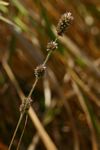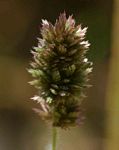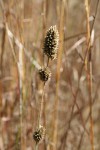Eragrostis congesta
Selected images: Click on each image to see a larger version and details of the record View all images (4)
Detailed records: Display species records QDS maps by: Google Maps Point records by Google Maps
Species details: Click on each item to see an explanation of that item (Note: opens a new window)
| Synonyms: |
Eragrostis eichingeri Pilg |
| Common names: | |
| Frequency: | |
| Status: | Native |
| Description: |
Caespitose perennial without rhizomes or stolons; culms up to 120 cm tall, erect or ascending, unbranched, glabrous at the nodes (but often pilose on the internodes), eglandular; basal leaf sheaths glabrous, chartaceous, terete, eglandular, persistent; ligule a line of hairs; leaf laminas 10–20 cm × 3–4 mm, linear, usually flat, loosely pilose with tubercle-based hairs, eglandular.Panicle 6–30 cm long, linear, the axis glabrous to hirsute, the spikelets on short barbate pedicels in 2–8 globular or ovoid clusters 0.5–2 cm in diameter, these distant along the central axis, but often the uppermost confluent and sometimes the lowermost branched, the short primary branches not in whorls, terminating in a fertile spikelet, eglandular.Spikelets 3–10 × 1.2–2 mm, narrowly oblong, laterally compressed, 4–22-flowered, the lemmas disarticulating from below upwards, the rhachilla fragile and breaking off above the glumes soon after the lower lemmas have begun to fall; glumes subequal, 1.2–2 mm long, reaching to just beyond the middle of the adjacent lemmas, keeled, lanceolate in profile, glabrous, acuminate at the apex; lemmas 1.5–2 mm long, keeled, ovate in profile, membranous with distinct lateral nerves, diverging from the rhachilla at c. 45°, those in opposite rows not imbricate, the rhachilla visible between them, grey-green flushed with purple, glabrous, acuminate at the apex, with or without an awn-point up to 0.5 mm long (the smallest spikelets with lemma merely acute or even obtuse and mucronate); palea persistent, glabrous on the flanks, the keels slender, wingless, scaberulous to scabrid; anthers 3, 0.3–0.4 mm long.Caryopsis c. 0.5 mm long, broadly elliptic. |
| Type location: |
|
| Notes: |
In Zimbabwe, this is essentially a species of the E Hghlands, but it is spreading, in a weedy manner, along the main Harare / Mutare Rd, as far west as Ruwa. Surprisingly not recorded for Mozambique. Unbranched perennial tufted grass, without stolons or rhizomes up to c. 1 m tall. Inflorescence a panicle of 2-8 ovoid to spherical, dense clusters of spikelets, separate along the central axis. Spikelets 3-10 mm long, narrowly oblong, laterally compressed, grey-green flushed with purple. |
| Derivation of specific name: | congesta: congested (refers to a tight inflorescence) |
| Habitat: | In wooded grassland, miombo woodland, vlei margins and roadsides, often in sandy soils and disturbed areas. |
| Altitude range: (metres) | 750 - 1650 m |
| Flowering time: | |
| Worldwide distribution: | DRC, Kenya, Tanzania, Uganda, Malawi, Zambia, Zimbabwe. |
| FZ divisions: | C,E |
| Growth form(s): | |
| Endemic status: | |
| Red data list status: | |
| Insects associated with this species: | |
| Spot characters: | Display spot characters for this species |
| Images last updated: | Sunday 1 March 2009 |
| Literature: |
Burrows, J.E. & Willis, C.K. (eds) (2005). Plants of the Nyika Plateau Southern African Botanical Diversity Network Report No. 31 SABONET, Pretoria Page 345. Chapano, C. & Mamuto, M. (2003). Plants of the Chimanimani District National Herbarium and Botanic Garden, Zimbabwe Page 24. Cope, T.A. (1999). Poaceae Flora Zambesiaca 10(2) Pages 121 - 122. (Includes a picture). Jackson, G. & Wiehe, P.O. (1958). An Annotated Check List of Nyasaland Grasses The Government Printer, Zomba, Nyasaland Page 39. Mapaura, A. & Timberlake, J. (eds) (2004). A checklist of Zimbabwean vascular plants Southern African Botanical Diversity Network Report No. 33 Sabonet, Pretoria and Harare Page 103. Ntore, S. & al. (2024). Checklist of the vascular plants of Burundi Page 196. Poilecot, P. (2007). Eragrostis species of Zimbabwe Éditions Quae,Versailles, France Pages 152 - 153. (Includes a picture). |
Other sources of information about Eragrostis congesta:
Our websites:
Flora of Burundi: Eragrostis congestaFlora of Malawi: Eragrostis congesta
Flora of Zambia: Eragrostis congesta
External websites:
African Plants: A Photo Guide (Senckenberg): Eragrostis congestaAfrican Plant Database: Eragrostis congesta
BHL (Biodiversity Heritage Library): Eragrostis congesta
EOL (Encyclopedia of Life): Eragrostis congesta
GBIF (Global Biodiversity Information Facility): Eragrostis congesta
Google: Web - Images - Scholar
iNaturalist: Eragrostis congesta
IPNI (International Plant Names Index): Eragrostis congesta
JSTOR Plant Science: Eragrostis congesta
Mansfeld World Database of Agricultural and Horticultural Crops: Eragrostis congesta
Plants of the World Online: Eragrostis congesta
Tropicos: Eragrostis congesta
Wikipedia: Eragrostis congesta



